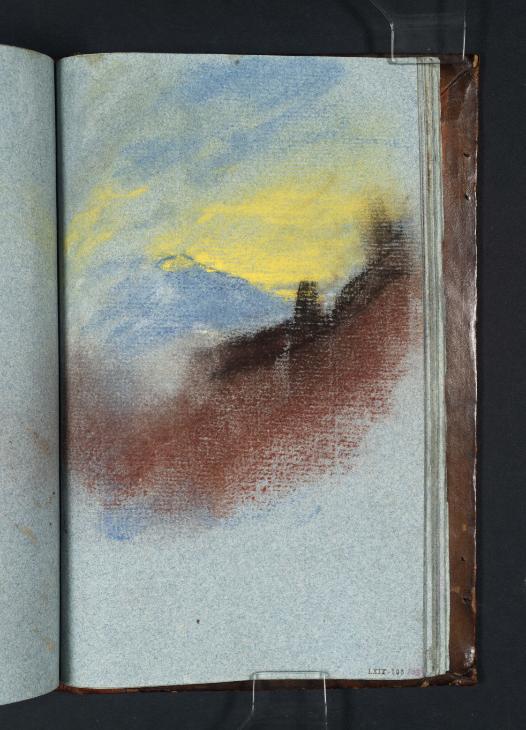Joseph Mallord William Turner Study for the Composition of 'Dolbadern Castle, North Wales' c.1799-1800
Joseph Mallord William Turner,
Study for the Composition of 'Dolbadern Castle, North Wales'
c.1799-1800
Joseph Mallord William Turner 1775–1851
Folio 102 Recto:
Study for the Composition of ‘Dolbadern Castle, North Wales’ c.1799–1800
D04118
Turner Bequest LXIX 103
Turner Bequest LXIX 103
Coloured chalks on blue laid paper, 210 x 135 mm
Inscribed by John Ruskin in red ink ‘103’ bottom right
Stamped in black ‘LXIX-103’ bottom right
Inscribed by John Ruskin in red ink ‘103’ bottom right
Stamped in black ‘LXIX-103’ bottom right
Accepted by the nation as part of the Turner Bequest 1856
References
1909
A.J. Finberg, A Complete Inventory of the Drawings of the Turner Bequest, London 1909, vol.I, p.173 LXIX 103 (as ‘Castle on hill. ... Study for the oil painting of “Dolbadarn Castle” exhibited 1800 (now in Diploma Gallery Royal Academy.)’ c.1800–2).
1963
Adrian Stokes, Painting and the Inner World, London 1963, pp.62–3.
1982
Jerrold Ziff, ‘Turner’s First Poetic Quotations: an Examination of Intentions’, Turner Studies, vol.2, no.1, Summer 1982, p.11 note 34.
1984
Martin Butlin and Evelyn Joll, The Paintings of J.M.W. Turner, revised ed., New Haven and London 1984, p.9 under no.12.
Turner submitted his painting Dolbadern Castle, North Wales to the Royal Academy exhibition of 1800, and presented it as his Diploma work on his election as full Academician in that year (Royal Academy of Arts, London).1 There are five other studies in coloured chalks for the composition in this book, on the rectos of folios 103, 107, 108, 111 and 112 (D04119, D04124, D04125, D04128, D04129; Turner Bequest LXIX 104, 108, 109, 112, 113). An offset of the present drawing is on the verso of D04125, indicating that they were once bound consecutively.
The sequence is unusual in being blocked out in broadly indicated areas of coloured chalk, described by Gerald Wilkinson as ‘a new world of colour and light’.2 This is certainly a new approach for Turner, but the organisation of these studies suggests that he conceived his subject from the start primarily in terms of tone: it was to be a bold exercise in dramatic chiaroscuro, imitating the most rugged compositions of Salvator Rosa (1615–1673), and including a group of figures embodying the theme of incarceration and heroic resistance in an episode from early Welsh history. A study of bound and guarded figures that may relate to this theme is on folio 67 recto (D04077). The parallel between bleak landscape and stern human events was brought out in the lines of verse that Turner appended to his catalogue entry for the picture when it was exhibited in 1800:
How awful is the silence of the waste,
Where nature lifts her mountains to the sky.
Majestic solitude, behold the tower
Where hopeless OWEN, long imprison’d, pin’d,
And wrong his hands for liberty, in vain.
Where nature lifts her mountains to the sky.
Majestic solitude, behold the tower
Where hopeless OWEN, long imprison’d, pin’d,
And wrong his hands for liberty, in vain.
These lines are generally considered to be Turner’s own, and are therefore his earliest published composition. They refer to Owain Goch, imprisoned at Dolbadarn from 1254 to 1277, when he was released under the terms of the Treaty of Conway, ironically the treaty that ended Wales’s independence after Edward I’s campaign to suppress the country, a subject that greatly interested Turner and which he planned to illustrate vividly in a work begun at this time; see the large unfinished watercolour, Tate D04168 (Turner Bequest LXX Q). Aside from the landscape of Snowdonia itself, he appears to have stimulated initially by Thomas Gray’s famous Ode The Bard (1757). A small oil study on panel for the Dolbadarn composition, including a group of captive and soldiers somewhat different from that in the finished work, belonged to Turner’s later patron and friend Munro of Novar, and was in his sale 1867. It was recorded as untraced by Martin Butlin and Evelyn Joll,3 but is now in the collection of the National Library of Wales, Aberystwyth.
It is noteworthy that Dolbadarn Castle inspired Turner to further technical experiments: in the watercolour study, Tate D04166 (Turner Bequest LXX O), that he made of another composition, based on a 1798 pencil drawing in the Hereford Court sketchbook (Tate D01300; Turner Bequest XXXVIII 47), he employed pigment mixed with flour or some other thickening agent to achieve a texturally rich medium in which to convey the romantic grandeur of the scene.
Verso:
Blank; slight offset from folio 103 recto opposite (D04119; Turner Bequest LXIX 104). Inscribed in pencil ‘768’.
Andrew Wilton
May 2013
How to cite
Andrew Wilton, ‘Study for the Composition of ‘Dolbadern Castle, North Wales’ c.1799–1800 by Joseph Mallord William Turner’, catalogue entry, May 2013, in David Blayney Brown (ed.), J.M.W. Turner: Sketchbooks, Drawings and Watercolours, Tate Research Publication, April 2016, https://www

